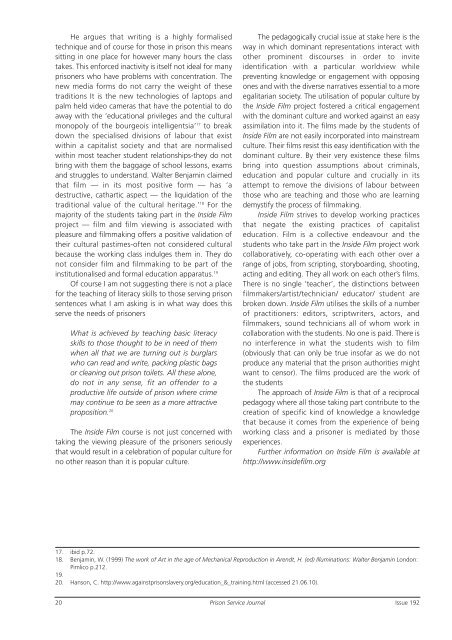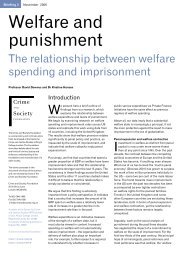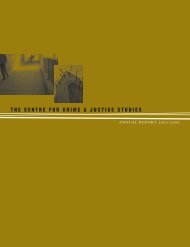PRISON SERVICE
PRISON SERVICE
PRISON SERVICE
- No tags were found...
You also want an ePaper? Increase the reach of your titles
YUMPU automatically turns print PDFs into web optimized ePapers that Google loves.
He argues that writing is a highly formalisedtechnique and of course for those in prison this meanssitting in one place for however many hours the classtakes. This enforced inactivity is itself not ideal for manyprisoners who have problems with concentration. Thenew media forms do not carry the weight of thesetraditions It is the new technologies of laptops andpalm held video cameras that have the potential to doaway with the ‘educational privileges and the culturalmonopoly of the bourgeois intelligentsia’ 17 to breakdown the specialised divisions of labour that existwithin a capitalist society and that are normalisedwithin most teacher student relationships-they do notbring with them the baggage of school lessons, examsand struggles to understand. Walter Benjamin claimedthat film — in its most positive form — has ‘adestructive, cathartic aspect — the liquidation of thetraditional value of the cultural heritage.’ 18 For themajority of the students taking part in the Inside Filmproject — film and film viewing is associated withpleasure and filmmaking offers a positive validation oftheir cultural pastimes-often not considered culturalbecause the working class indulges them in. They donot consider film and filmmaking to be part of theinstitutionalised and formal education apparatus. 19Of course I am not suggesting there is not a placefor the teaching of literacy skills to those serving prisonsentences what I am asking is in what way does thisserve the needs of prisonersWhat is achieved by teaching basic literacyskills to those thought to be in need of themwhen all that we are turning out is burglarswho can read and write, packing plastic bagsor cleaning out prison toilets. All these alone,do not in any sense, fit an offender to aproductive life outside of prison where crimemay continue to be seen as a more attractiveproposition. 20The Inside Film course is not just concerned withtaking the viewing pleasure of the prisoners seriouslythat would result in a celebration of popular culture forno other reason than it is popular culture.The pedagogically crucial issue at stake here is theway in which dominant representations interact withother prominent discourses in order to inviteidentification with a particular worldview whilepreventing knowledge or engagement with opposingones and with the diverse narratives essential to a moreegalitarian society. The utilisation of popular culture bythe Inside Film project fostered a critical engagementwith the dominant culture and worked against an easyassimilation into it. The films made by the students ofInside Film are not easily incorporated into mainstreamculture. Their films resist this easy identification with thedominant culture. By their very existence these filmsbring into question assumptions about criminals,education and popular culture and crucially in itsattempt to remove the divisions of labour betweenthose who are teaching and those who are learningdemystify the process of filmmaking.Inside Film strives to develop working practicesthat negate the existing practices of capitalisteducation. Film is a collective endeavour and thestudents who take part in the Inside Film project workcollaboratively, co-operating with each other over arange of jobs, from scripting, storyboarding, shooting,acting and editing. They all work on each other’s films.There is no single ‘teacher’, the distinctions betweenfilmmakers/artist/technician/ educator/ student arebroken down. Inside Film utilises the skills of a numberof practitioners: editors, scriptwriters, actors, andfilmmakers, sound technicians all of whom work incollaboration with the students. No one is paid. There isno interference in what the students wish to film(obviously that can only be true insofar as we do notproduce any material that the prison authorities mightwant to censor). The films produced are the work ofthe studentsThe approach of Inside Film is that of a reciprocalpedagogy where all those taking part contribute to thecreation of specific kind of knowledge a knowledgethat because it comes from the experience of beingworking class and a prisoner is mediated by thoseexperiences.Further information on Inside Film is available athttp://www.insidefilm.org17. ibid p.72.18. Benjamin, W. (1999) The work of Art in the age of Mechanical Reproduction in Arendt, H. (ed) Illuminations: Walter Benjamin London:Pimlico p.212.19.20. Hanson, C. http://www.againstprisonslavery.org/education_&_training.html (accessed 21.06.10).20 Prison Service JournalIssue 192











